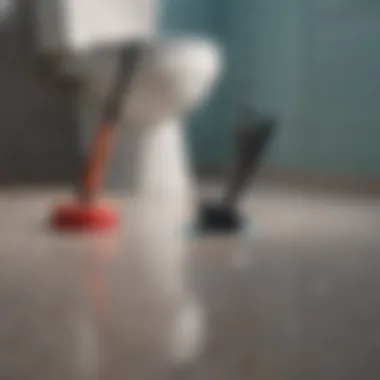Unclog a Toilet with Dish Soap: A Smart Home Solution


Intro
Clogged toilets are a frustrating experience that every homeowner faces at one point or another. The methods we typically think of, like plunging or using chemical drain cleaners, can often be messy or harmful to the environment. In recent years, there has been a shift towards utilizing more environmentally friendly solutions for common household problems. One such method is using dish soap to unclog a toilet. This article delves deep into this innovative approach, highlighting its practicality, ease, and effectiveness.
Instead of reaching for harsh chemicals or calling a plumber immediately, an offer of warmth and convenience is within reach. The combination of dish soap and warm water can work wonders to clear those stubborn clogs without damaging your plumbing.
As we explore how to unclog a toilet using dish soap, we will provide a detailed guide. This includes an overview of the necessary materials, step-by-step instructions, and helpful troubleshooting tips. This information serves to empower homeowners and design enthusiasts alike, offering strategies that resonate with those who appreciate the beauty of well-maintained living spaces.
Getting started with this method can create a sense of achievement while also ensuring that your bathroom remains a clean and pleasant part of your home.
Intro to Toilet Clogs
Toilet clogs are a common issue faced by homeowners, yet they often cause significant disruption in daily life. Understanding this problem is pivotal, as it can highlight the deeper plumbing challenges that might be at play. This section provides a foundational comprehension of what leads to clogs and their implications on household functionality.
Understanding Common Causes of Clogs
Clogs can arise from various household activities. The most frequent culprits include excessive toilet paper use, flushable wipes, and foreign objects inadvertently dropped into the toilet. These items can accumulate over time, leading to blockage. Hair, soap scum, and other debris can also contribute to this issue, especially in older plumbing systems.
Moreover, the structure of the plumbing itself can also be a factor. Narrow pipes or those with bends can trap waste material more easily. A lack of regular maintenance can compound these issues, making it essential for homeowners to be aware of their plumbing systems and take proactive measures to prevent clogs.
Impact of Clogs on Home Functionality
A clogged toilet does not simply inconvenience users. It can also signify more serious plumbing issues. When toilets become clogged, it hinders the flow of water, leading to potential backups that can damage flooring and bathroom fixtures. Additionally, such disruptions can interfere with basic household routines, causing frustration.
The implications extend beyond the immediate inconvenience. Ignoring persistent clogs can lead to more severe problems in the plumbing system, resulting in costly repairs. Regular attention to household plumbing, including understanding how clogs develop, can be vital for maintaining a well-functioning home.
"Homeowners should take toilet clogs seriously; they not only disrupt daily life but can also be indicators of underlying plumbing issues that need attention."
In essence, an awareness of the causes and impact of toilet clogs equips homeowners with the knowledge necessary to manage their plumbing effectively and prevent complications.
The Role of Dish Soap in Plumbing
Dish soap is more than just a staple in the kitchen; it plays a significant role in plumbing maintenance, particularly in unclogging toilets. Understanding its importance is crucial for homeowners who seek effective and environmentally friendly methods for dealing with clogs. This section elaborates on what makes dish soap a viable solution and the benefits it offers.
Chemical Composition of Dish Soap
Dish soap is formulated primarily from surfactants, which are compounds that reduce surface tension in liquids. These surfactants allow water to spread and wet surfaces more easily. Ingredients often include sodium lauryl sulfate and other derivatives that assist in breaking down grease and grime. The effectiveness of dish soap in plumbing derives from its ability to slice through fat and oils, making it useful in dislodging stubborn clogs caused by soap scum or food residue.
Additionally, most dish soaps are biodegradable, providing an eco-friendly choice. The gentle nature of these soaps makes them less likely to harm plumbing systems compared to harsher chemical alternatives. This aspect is particularly appealing for homeowners looking to maintain a sustainable household while effectively resolving plumbing issues.


How Dish Soap Aids in Clog Removal
The mechanism by which dish soap aids in clog removal is multifactorial. When dish soap is introduced into a clogged toilet, it interacts with the water and the blockage in several ways:
- Lubrication: Dish soap lubricates the insides of the toilet bowl and pipes, allowing the clog to slide more easily through the plumbing system.
- Breakdown of Materials: As the soap mingles with water, it begins to break down organic materials such as grease, hair, and waste that contribute to clog formation.
- Heat Retention: When used in conjunction with hot water, dish soap can help maintain a higher temperature in the pipes, promoting the melting or fragmentation of solid blockages. The combination of heat and soap creates an effective solution for loosening stubborn lumps.
Homeowners can benefit from this method not just for its practicality but also for the minimal expense involved. A bottle of dish soap is relatively inexpensive compared to professional plumbing services, and its ease of use makes it an appealing option for quick home maintenance tasks.
"Using dish soap for unclogging toilets is a smart, eco-friendly method that combines efficiency with cost-effectiveness."
Overall, dish soap serves as an excellent, non-invasive solution for toilet clogs, making it a valuable tool in the homeowner's arsenal. By understanding both the chemical properties of dish soap and its practical application, individuals can better navigate common plumbing challenges.
Materials Required for Unclogging
Understanding the materials needed for unclogging a toilet using dish soap is crucial for achieving effective results. Proper supplies not only help in the unclogging process but they also support the overall efficiency of the method. By gathering the necessary tools and materials in advance, homeowners can address potential clogs with confidence and minimize frustration.
Essential Supplies for the Process
When tackling a clogged toilet with dish soap, a few essential supplies will ensure success. Here are some of the primary materials needed:
- Dish Soap: Select a liquid dish soap that can easily mix with water. Brands like Dawn or Palmolive are popular choices, known for their grease-cutting properties.
- Hot Water: Heat some water in a kettle or on the stove. However, do not let it boil. Extremely hot water can crack porcelain in toilets, so a warm temperature is safest.
- Toilet Plunger: A standard toilet plunger is useful, even if the main method involves dish soap. It can help dislodge more stubborn clogs if needed.
These items form the foundation of your unclogging toolkit and should be readily available for a swift response to any clog incident.
Optional Tools for Enhanced Efficiency
In addition to the essential supplies, there are some optional tools that can make the unclogging process smoother. Consider acquiring the following:
- Rubber Gloves: Wearing gloves can keep your hands clean and hygienic throughout the process.
- Bucket: A bucket can be helpful for transporting hot water without the risk of spills.
- Hose or Funnel: A hose can direct water into the toilet more precisely, while a funnel can prevent splashes when pouring.
- Inspection Mirror: This tool enables you to see into tight spaces, helping assess the clog if further action is needed.
Having these optional tools can improve your efficiency and add an extra layer of preparedness when dealing with toilet clogs.
Step-by-Step Instructions
The practical application of dish soap for unclogging toilets rests on a structured approach. Step-by-step instructions are crucial for clarity and effectiveness, particularly when addressing potential frustrations that can arise during home maintenance tasks. By breaking down the process into manageable steps, homeowners can increase their chances of successful unclogging, minimizing time and effort.
Initial Preparation and Safety Measures
Before embarking on this unclogging endeavor, some preparations are necessary. First, ensure that you have the right materials at hand. This includes dish soap, hot water, and possibly a toilet plunger. Gathering these items ahead of time makes the process smoother and less chaotic. Next, consider your personal safety. If the toilet overflowed, put on rubber gloves to protect your hands from any potentially harmful substances. Additionally, keep a bucket nearby to catch any excess water or debris that might spill out during the process. This might help in keeping the work area clean and organized.
Application of Dish Soap


Once preparations are complete, the next step involves the application of dish soap. Pour approximately one cup of dish soap directly into the toilet bowl. Allow the soap to settle for about 10-15 minutes. This waiting period is crucial as it gives the soap time to penetrate the clog, aiding in the breakdown of any solid materials. The unique lubricating properties of dish soap help to make the clog easier to dislodge. This method is effective as the soap reduces friction, allowing any built-up matter to move more freely.
Incorporating Hot Water Effectively
After the dish soap has had some time to work, introduce hot water into the mix. It's important to use hot water, not boiling, to prevent damage to the toilet’s porcelain. Boiling water can create cracks due to rapid temperature changes. Instead, heat some water in a kettle to a hot but safe temperature and pour it gently into the toilet bowl from waist height. This height allows for effective distribution without causing splashing. The hot water complements the dish soap, helping to soften and dissolve the clog further.
Flushing the Toilet: When and How
Finally, flushing is a critical step that signifies the culmination of your efforts. Wait for about 10 to 15 minutes after adding the hot water before attempting to flush. This allows both the soap and hot water to work together on the clog. When ready, flush the toilet and observe the results. If the toilet does not flush properly, avoid repeating the process immediately. It may take a few attempts. Always remember to maintain a clean workspace, as dealing with clogged toilets can be messy.
It's essential to have patience through this process; rushing can lead to frustration and further clogs.
By following these detailed steps, homeowners can efficiently tackle a clogged toilet using dish soap, promoting effective and eco-friendly home maintenance.
Troubleshooting Common Issues
When addressing a clogged toilet, it is essential to recognize the potential challenges that may arise during the unclogging process. Understanding common issues is vital for homeowners, as even a straightforward method like using dish soap can sometimes lead to complications. This section will explore what to consider when encountering persistent clogs and how to identify underlying problems. Successfully troubleshooting these issues can save time, money, and prevent further damage.
What to Do if the Clog Persists
If the clog does not clear after the initial attempt to use dish soap, there are several steps to take:
- Give It Time: Sometimes, the soap requires sufficient time to work through the blockage. Wait for 15 to 30 minutes before trying again.
- Reapply Dish Soap: Consider adding more dish soap to the toilet bowl. The additional lubricant can help break down stubborn debris that may be contributing to the clog.
- Use a Plunger: A plunger can often provide the extra force needed to dislodge the blockage. Ensure that a flange plunger is used, as it is designed for toilets and provides a better seal.
- Check Water Level: Inspect the water level in the toilet bowl. A low water level may hinder the effectiveness of your plunging efforts.
- Seek Professional Help: If all else fails, it may be necessary to contact a plumber. Persistent clogs can indicate more serious plumbing issues that require professional diagnosis.
"When dealing with toilet clogs, patience is often your best tool. Rushing can lead to accidental damage."
Identifying Deeper Problems
Sometimes, a recurring clog could signal a broader issue within the plumbing system. It's essential to identify these underlying problems to address them effectively:
- Old or Compromised Pipes: Deteriorating pipes can lead to repeated clogs. Look out for rust, leaks, or unusual noises.
- Tree Root Intrusion: Roots can penetrate underground pipes, causing restricted flow and clogs. If you notice slow drainage in multiple areas of your home, investigate this possibility.
- Foreign Objects: Items that should not be flushed can cause blockages. If you suspect this, it's essential to check the toilet for any visible obstructions.
- Ventilation Issues: Adequate venting is crucial for proper drainage. Blocked vents can lead to poor drainage and frequent clogs.
Being vigilant about these deeper plumbing problems can save homeowners from the hassle of prolonged issues and costly repairs.
Preventative Measures for Future Clogs
Toilets are an essential part of daily home life. Preventing clogs is crucial for maintaining functionality and comfort. The focus on preventative measures can save homeowners from the inconvenience and potential frustration of dealing with clogs. By adopting a few practical strategies, a smoother toilet operation can be achieved.
Regular Maintenance Tips


Proactive care is vital. Homeowners should regularly inspect their toilets. This involves checking for leaks and observing the water flow during flushing. A good habit is to clean the toilet weekly. Use a gentle cleaner to prevent build-up. Additionally, occasional deep cleaning will ensure that no blockages form over time.
Another point is to flush the toilet only with waste. Paper products specifically designed for toilets can also add to the waste. Avoid flushing items like baby wipes and feminine hygiene products. Even if they say they are flushable, they may lead to big issues later.
- Inspect components such as flappers and fill valves regularly.
- Schedule semi-annual checks of the plumbing.
- Use a toilet brush to clean under the rim.
Best Practices for Toilet Use
Understanding how to utilize the toilet properly can prevent clogs. It is essential to educate everyone in the household about what can and cannot be flushed. One significant action to take is limiting the use of excessive toilet paper in a single flush. Breaking it into smaller amounts can help facilitate smoother flushing.
Another aspect is to remind users to avoid any non-biodegradable items. Items like cotton balls, paper towels, or other foreign objects ruin the plumbing system. In homes with children, it may help to keep the bathroom door closed to limit unauthorized usage.
In summary, simple awareness and responsible usage can prevent many toilet issues. Regular maintenance and best practices foster a more efficient toilet system, minimizing the risk of clogs. Keeping a clean and well-usage aware environment leads to long-term satisfaction with plumbing.
Environmental Considerations
The significance of environmental considerations in home maintenance cannot be overstated. More homeowners and renters prioritize eco-friendly solutions that minimize impact on the planet. This article features an effective method for unclogging toilets using dish soap, which stands out as a practical and sustainable option.
Eco-Friendly Home Maintenance
In recent years, there has been a shift towards sustainable housekeeping. Many people search for methods that do not rely on harsh chemicals, which can pollute water sources and harm ecosystems. Using dish soap for unclogging toilets is a step in the right direction. Dish soap is biodegradable and contains fewer toxic substances than many commercial drain cleaners. This makes it a safer alternative for not only your plumbing system, but also for the environment.
Using eco-friendly solutions can also extend to other areas of home maintenance. Regularly cleaning with natural ingredients like vinegar and baking soda can further enhance your eco-conscious cleaning routine. Embracing such practices contributes to a healthy planet and a healthier home.
Comparing Commercial Products to Dish Soap
When considering methods for unclogging a toilet, it is vital to evaluate commercial products versus dish soap. Many drain cleaners available on the market contain caustic substances, potentially damaging pipes over time. In contrast, dish soap offers an effective solution without the risks associated with chemical cleaners.
There are several benefits to using dish soap:
- Safety: It poses less risk to humans and pets, which is a critical consideration in households.
- Cost-Efficiency: Dish soap is typically more affordable than specialized cleaning products.
- Accessibility: Most homes already have dish soap on hand, making it an easily accessible option for an emergency situation.
Culmination: The Practicality of Using Dish Soap
Using dish soap as a method to unclog a toilet serves as a practical solution for homeowners in various scenarios. This technique embodies a blend of simplicity and effectiveness, highlighting the advantages of choosing readily available household materials over more complex or expensive alternatives.
Summary of the Method's Effectiveness
The process of utilizing dish soap for unclogging toilets combines everyday items with basic plumbing principles. Dish soap breaks down the materials causing clogs, acting as a lubricant that allows blockages to slide through the plumbing. When complemented by hot water, the effectiveness of this method increases significantly. The soap not only addresses the immediate issue but is also friendly to the plumbing infrastructure, reducing the risk of damage commonly associated with harsher chemical solutions. This makes it accessible for any homeowner, regardless of plumbing expertise. For those looking for an efficient means to restore functionality without professional help, this method proves worthwhile.
Overall Benefits for Homeowners
Homeowners gain numerous benefits from adopting dish soap as a primary tool for dealing with toilet clogs. First, it is cost-effective. Most households already possess dish soap, eliminating the need for additional purchases. Furthermore, it is an environmentally-sound approach, avoiding toxic chemicals that may harm ecosystems or wastewater systems.
Beyond immediate convenience, employing dish soap fosters a more hands-on relationship with home maintenance. This understanding encourages individuals to handle minor plumbing issues confidently, likely reducing their reliance on professionals for minor repairs. Finally, this method reflects a mindful approach to home care that aligns with an overall ethos of sustainability and practicality.
In summary, dish soap offers an efficient, economical, and environmentally friendly solution for unclogging toilets, making it a go-to option for homeowners.







